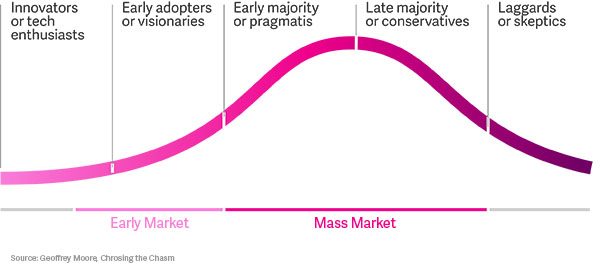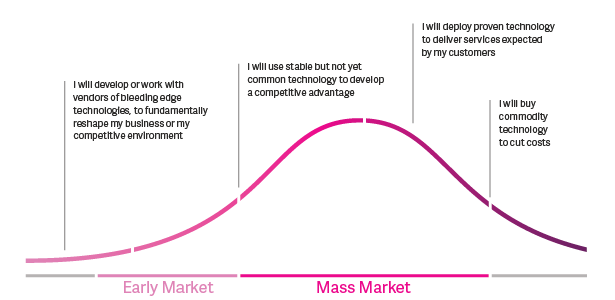Find out how experiences and attitudes impact technology decision making processes.
Buyer experiences and motivations often impact our decision making processes when it comes to choosing the right technology options.
A small to medium size business by its very nature has few decision makers, so its decision making culture is often a function of its senior leaders’ attitudes, experiences and beliefs.
An unsuccessful past experience of attempting to build something, or a failed partnership with another business, can change the way someone makes decisions for the rest of their life. Further, and perhaps more importantly, one’s attitude to technology adoption can have a large influence on a person’s build, buy, partner approach.
‘The Technology Adoption Cycle’ popularised by Geoffrey Moore in the early 90s with his classic book ‘Crossing the Chasm: Marketing and Selling High-tech Products to Mainstream Customers’, shows how different attitudes influence the adoption of a technology product over its life span.

In terms of technology adoption by businesses, the book proposes that early on in a product’s marketplace existence, buyers (the innovators or tech enthusiasts) are motivated by the chance to gain a dramatic advantage over their competition through innovation, so they are willing to assume a larger risk in return for a large potential reward. As the technology proves its worth over time, a larger group of buyers (early adopters or visionaries) are willing to adopt it to gain business advantage.
Once the technology is well-accepted, another large group (the early majority or pragmatists), will adopt the technology out of fear of losing business to their competition. Then a group who have lagged behind will gradually start to see the opportunity to use the technology once all the problems have been solved, the technology is simple to use, and the price has dropped to its lowest levels (the late majority or conservatives). Finally, there is a group that may never adopt the technology at all (the laggards or sceptics).
Buyer attitudes influence the decision making process
Using the decision making archetypes that we have just described, you can determine where you and your selection committee or board sit within this technology adoption cycle, and how their position on the cycle can cloud (or enhance) their objective decision making skills when considering to buy, build or partner in the development of new technology.

- Innovators are willing to develop technology or work with a partner to truly be innovative. They recognise that it can take some time to build a new solution. For them, the technology might not need to be entirely finished or stable before they are happy to release it. They are happy to be the BETA testers. Innovators are looking for flexibility and technical expertise.
- Early adopters are looking for the technology to be more developed, and more stable before they adopt it as their chosen solution and release it to their staff and clients. But they are still willing to rely on early proven products to achieve a competitive advantage. They understand that development may still take time. Early adopters will want to partner with experienced professionals and will look for some (albeit limited, if it is a new technology) proof in the technology or solution.
- The early majority are pragmatic and require the technology solution to exist in a more ‘complete’ state before they are willing to trust it. They will expect the technology to be robust, feature-rich and available quickly. They recognise that it is better to buy or partner for new features and functionality, or for competitive differentiation than to spend time developing major new features themselves. The early majority want packaged solutions, a choice of suppliers, good service, easy installation, and maybe performance guarantees.
- The late majority will be the last to implement a new technology. They need a packaged product, with proven results, which can integrate seamlessly with their systems. They want a foolproof installation process and high levels of support from the supplier. Above all they are looking for a low cost, easy to use technology option. These are the kind of people that probably think Excel is still the best financial planning tool available!
So, where do you sit on the spectrum? Do you think that your own biases have ever come in the way of objective decision making?
At Netwealth, we often use objective based frameworks for technology decision making. Why don’t you read our latest thoughts on the topic and join the discussion?